Bienvenidos a Dia Hispano: Welcome to Hispanic Day
Published on Monday, March 13, 2023
By: Gary Pettus, gpettus@umc.edu
Photos By: Jay Ferchaud/UMMC Photography
Angela Sarat Sontay angled the colored tips of the auto-injector just so – blue to the sky, orange to the thigh – and thrust the needle into Roberto’s flesh.
As the 16-year-old admitted later, she was “nervous” while administering the simulated jolt of epinephrine; but if Roberto had been a man instead of a manikin, she might have saved his life.
It was a first for Angela, this serious imitation drama staged in a School of Medicine simulation lab at the University of Mississippi Medical Center; still, the Morton High School junior comes to the aid of actual living, breathing patients all the time: She speaks for them.
At their request, Angela translates for residents of her Spanish-speaking community, accompanying them to Scott County’s doctor’s and dentist’s offices – a responsibility that “makes me feel very useful and very happy,” she said.
As it happened, “feeling useful and happy” could have been the theme for an event that drew Angela and another 99 or so Mississippi high school and college students to UMMC this month: the School of Medicine’s first-ever Hispanic Day.
The invitees traveled from as far away as Tupelo, a three-hour drive, to learn, among other things, how to suture, perform CPR, accomplish airway management, detect a heart murmur, and rescue Roberto from anaphylactic shock.
As speakers, guides and presenters for the March 3 event took pains to suggest, travelers on the road to usefulness and happiness are often beckoned by health care careers – professions that beg for more providers with ties to, and an empathy for, patients from Hispanic communities.
To that point: By 2034, the U.S. will have a “deficit” of 113,758 Hispanic physicians, claims a study published last year. In Mississippi, the Hispanic/Latino population represents 3.5 percent of the total, or around 103,000 residents, per U.S. Census Bureau estimates.
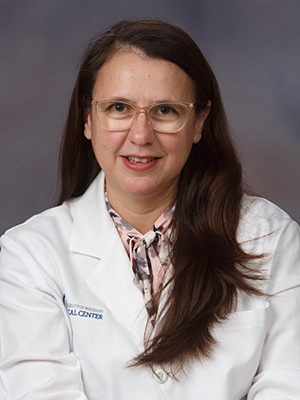 Yanes Cardozo
Yanes CardozoNo wonder, then, that Dr. Licy Yanes Cardozo greeted the visiting students with: “Buenos dias! Me encanta ver tanta gente hoy aca; realmente es emocionante para mi.”: “Good morning! I love to see so many people here today; this is really exciting for me!”
She brought that excitement to bear as she told her personal story. “My family believed that education was the only way for me to get out of the cycle of poverty,” said Yanes Cardozo, who grew up in Paraguay. Today, she is an associate professor of cell and molecular biology and an associate professor of medicine-endocrinology at UMMC.
Like her, many of the students she welcomed are from families whose relatives may speak mostly, or only, Spanish. The students speak both.
By saluting them in her native language, Yanes Cardozo was acknowledging the bilingual character of her audience – an attribute that would serve them, and their future patients, well. “We have data showing that when patients follow up with a physician of their same culture, they do better,” she said.
“So, we need you for exactly who you are,” she implored her listeners. “We need your energy, your dreams, your passion.”
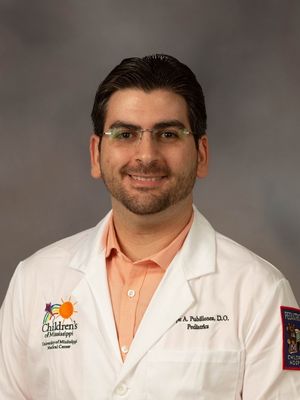 Pubillones
PubillonesAs a member of a Hispanic Day health care panel, Dr. Felipe Pubillones, for one, took on the topic of translation as well.
“It’s dumbfounding to me how hard it is to find a Spanish teacher and a Spanish translator sometimes,” said Pubillones, a pediatrics resident who was brought up in Miami by parents originally from Cuba.
Asked by a student what he’s thinking about when he walks into a room and sees a patient, Pubillones replied: “I think that they’re coming to me because I’m Hispanic; so, the something I’m giving them is less stress.”
As Yanes Cardozo noted: “The language barrier is a huge thing in medicine.” But, in this, medicine isn’t alone.
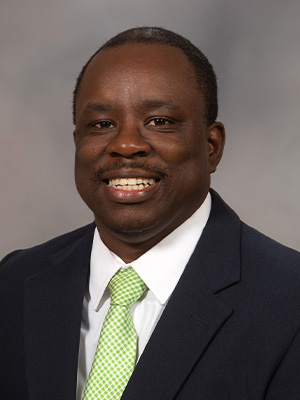 Coleman
ColemanYes, the sponsors of Hispanic Day were the School of Medicine’s Office of Admissions and IMPACT the RACE; but organizers, including Dr. Dan Coleman, medical school outreach director, recruited UMMC faculty and several of the campus’ 3,000 students to represent a variety of health professions.
This was a wise decision, as a poll of the visiting students showed. Supervised by Dr. Loretta Jackson-Williams, professor of emergency medicine and vice dean for medical education, the survey revealed that a plurality are most interested in exploring nursing, followed closely by medicine, then by allied health, dentistry, pharmacy and “other.”
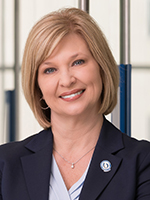 Woodward
Woodward“There are opportunities where you can make a difference with patients and you may not even be aware of them,” Dr. LouAnn Woodward, vice chancellor for health affairs and dean of the School of Medicine, said in her welcoming remarks.
“We want you to know that a health care field is a very real possibility for you,” said Woodward, who listed a variety of career choices.
As for the medical school, she said, “we have very few Hispanic students; we want to do a better job. This, today, is a start.”
Only 16 students in the medical school’s four current classes identify as Hispanic, Coleman said, an average of four per class.
One is Emilio Luna-Suarez of Philadelphia; nothing like Hispanic Day existed when he was trying to get into medical school, he said.
“It was almost like going in blind, trying to find out what you need to know,” said the second-year medical student.
“So, [Hispanic Day] is a huge opportunity for these students here today to get exposure, to get to learn something new. Even if it’s just for one day, it may have an impact for a lifetime.”
While many of the day’s guests would be the first in their families to be, for instance, a doctor or nurse, the Zevallos sisters are a trio of exceptions. The Madison residents, who attend St. Andrew’s Episcopal School in Ridgeland, are being brought up by a gastroenterologist and an internist.
Although Isabelle, 14, isn’t sure if health care is for her, Alexandra, 18, hopes to become a certified registered nurse anesthetist; Gabrielle, 15, may be her family’s first neurosurgeon.
Their parents’ influence in this regard is significant, but only goes so far, Gabrielle said. “Wanting to do medicine stemmed from ourselves,” she said.
Nodding toward Alexandra, she said: “We might start our own practice together.”
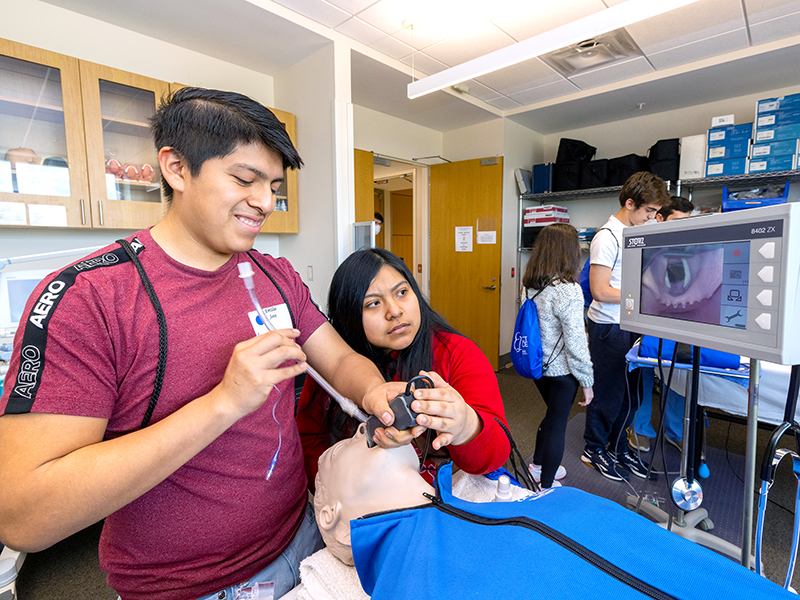
Morton High School students Emilio Jose, left, and Edna Perez-Ambrocio practice their intubation skills on a compliant manikin.
More typical perhaps are students like Edna Perez-Ambrocio, 17, a Morton High School junior whose Guatemalan-born parents are Spanish speakers primarily. During their doctors’ visits, she is their interpreter. She is torn between a career in education and one in health care.
“My parents say I should become a doctor,” Edna said.
Near the conclusion of Hispanic Day, she sounded like someone who just might make her parents’ wish come true.
“It’s been heart-warming,” Edna said. “Seeing how everyone is trying to convince you to be here. They show you what you need to do. It’s based on reality; it’s not just in your imagination any more.”